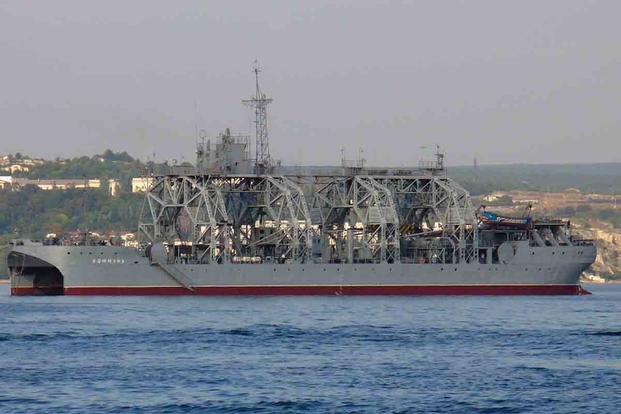Many navies have very old ships still in commission and on active duty. The U.S. Navy’s USS Constitution was launched in 1797 and is currently the only active U.S. vessel to have sunk an enemy vessel. The United Kingdom's HMS Victory was launched in 1778 and has served for more than 240 years. But for all their grandeur and history, most countries just don’t actually send their aging hulls to war zones.
Russia, it turns out, has no problem with that: The Russian salvage ship Kommuna has been in service since 1915, when Tsar Nicholas II ruled the Russian Empire. After surviving two world wars, decades of Soviet rule and Russia’s subsequent post-Soviet decline, the onetime submarine tender was nearly taken to the bottom of the Black Sea by a Ukrainian anti-ship missile on April 21, 2024.
The Kommuna first entered service as the submarine tender Volkhov, part of the Imperial Russian Navy, in July 1915. When Russia became the Soviet Union in 1922, the Volkhov was renamed the Kommuna and went to work for the Soviet Navy, raising ships from the ocean’s depths. Now officially designated a rescue ship, it doesn’t carry armaments, but is capable of raising sunken combat vessels, something Ukraine is eager to prevent.
During World War II, the Kommuna fought against Nazi Germany’s Siege of Leningrad between 1941 and 1943, raising and repairing tens of thousands of tons of trucks, tanks and ships. The ship sailed down the Volga River, where it worked through the end of the war, continuing to raise and repair Soviet vessels. For their service during the “Great Patriotic War,” as World War II is known in Russia, the crew received the Defense of Leningrad medal.
Since the end of World War II, It underwent just three complete refits during its long life -- and now may be headed for a fourth.
The Kommuna is believed to have sailed for the Black Sea port at Sevastopol, which Russia currently occupies, to prepare an operation to raise the missile cruiser Moskva, flagship of the Russian Black Sea Fleet, which was sunk by Ukrainian Neptune anti-ship missiles 80 nautical miles south of Odessa on April 14, 2022.
Social media reports of a Russian ship on fire in Sevastopol were later revealed to be the Kommuna, which was the target of more Ukrainian Neptune missiles. Ukraine claimed responsibility for the attack, while Crimea’s unrecognized Russian governor, Mikhail Razvozhayev, denied the assault resulted in a direct hit.
Razvozhayev said Russian forces "repelled an attack by an anti-ship missile" earlier in the day along the north of the port city, indirectly hitting the Kommuna. "The falling fragments caused a small fire, which was quickly extinguished," Razvozhayev added.
The Kommuna was not sunk in the attack, but Ukrainian officials believe damage sustained to the vessel is enough to ensure it can no longer raise the Moskva from the bottom of the Black Sea.
Due to the damage inflicted on the Black Sea Fleet in Crimea since Russia’s invasion of Ukraine began in 2022, the Russian Navy has moved most of its major warships out of Sevastopol and to Novorossiysk, in the Krasnodar region of Russia. Though out of range of Ukrainian missiles, Novorossiysk isn’t necessarily safe for Russian warships. Ukrainian forces used sea drones to damage the Olenegorsky Gornyak, a Russian landing ship based at Novorossiysk, in August 2023.
The rest of the Russian Black Sea Fleet has taken a beating elsewhere since the conflict with Ukraine began. Along with the sinking of the Moskva, a number of patrol boats and landing ships were sunk by Ukrainian forces. The Russian corvettes Ivanovets, Veliky Ustyug and Askold were also destroyed using a combination of cruise missiles, anti-ship missiles and sea drones.
Russia was probably right to withdraw the Kommuna from Crimea; as Russia’s oldest ship still in service, it’s a prime target whose structure was built long before missiles were a threat. When the ship was launched, the biggest threat to ships at sea were torpedoes. Today, it faces explosive-laden unmanned boats, underwater and airborne drones, along with the anti-ship missiles that just knocked the Kommuna out of Russia’s war with Ukraine.
Want to Learn More About Military Life?
Whether you're thinking of joining the military, looking for post-military careers or keeping up with military life and benefits, Military.com has you covered. Subscribe to Military.com to have military news, updates and resources delivered directly to your inbox.













